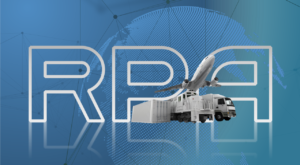Automating business processes is nothing new. The Industrial Revolution was all about automating processes. Wikipedia notes, “The Industrial Revolution was the transition to new manufacturing processes in Europe and the US, in the period from about 1760 to sometime between 1820 and 1840. This transition included going from hand production methods to machines, new chemical manufacturing and iron production processes, the increasing use of steam power, the development of machine tools and the rise of the factory system.”[1] The fact of the matter is process automation has continued unabated for the past 250 years. Most of that automation has been mechanical; but, the computer age added a new twist to automation. At first, computers were used to control mechanical devices. Eventually, however, computers were used to control virtual processes as well. Back in 2012, Pat Geary (@EvangelistBlue), chief evangelist at Blue Prism, coined the term “robotic automation” which morphed into Robotic Process Automation (RPA).
Although the term seems to imply mechanical robots are involved, they’re not. The robots to which the term refers are software “bots.” Ashish Deshpande, CEO at frevvo Inc., explains, “RPA uses software robots (bots) to automate individual tasks performed by human beings by mimicking their interactions with software systems. Think about the familiar Excel macro recorder except that it works with legacy screens and browsers, not just Excel. RPA bots simply use the existing user interface to log into systems, copy and paste data, move files and perform other mechanical tasks that don’t add much value but take humans a significant amount of time.”[2] Deshpande distinguishes RPA from business process automation. He explains, “Process automation (often called business process management or BPM) concerns itself with not just individual tasks but with the overall end-to-end process. It’s much more about enabling faster and more accurate decision making rather than faster data entry.” It’s an important distinction.
RPA is growing fast
Deshpande notes, “The hype around robotic process automation seems to be at an all-time high, and RPA is a crucial component of digital transformation initiatives everywhere.” Blue Prism’s Geary asserts RPA is becoming a high priority in many corporations. He writes, “RPA — is a software category that is driving seismic change across the international workplace. RPA was originally designed to provide an easy-to-control ‘Digital Workforce’ (software robots) that informs, augments, supports, and assists people in the automated fulfillment of service based tasks. With both routine and non-routine based-tasks being transformed, RPA is topping the corporate agenda.”[3] Like many emerging technologies, RPA has no universal standard and Geary insists that’s a problem. He explains:
“With all this excitement comes hype and confusion within a rapidly expanding RPA marketplace. With over 45 ‘claimed’ RPA products now on offer — all varying significantly in quality and approach — greater clarity will be required on this complex and relatively misunderstood technology. As the RPA market starts to mature in 2019, a true RPA reference point will emerge — where the technology is run by business users through a collaborative platform — while operating within the full governance and security of the IT department. Having a universal RPA standard will become more important than ever to ensure that organizations avoid choosing either the wrong options or bad, poorly designed, options.”
Deshpande believes standards are only one of the problems associated with RPA. Although RPA may sound futuristic, he believes, “The macro-recorder nature of RPA is also its biggest con.” He points out the following RPA limitations:
- If there’s a minor change to the UI or data, the RPA stops working. The bots can’t simply adjust their behavior like humans can.
- An even bigger problem is that the dependency on the legacy UI makes it much harder to change and modernize the underlying system. Introducing RPA may temporarily breathe new life into your legacy system, but it can divert attention from far more significant strategic initiatives that may be truly disruptive.
- RPA requires significant IT support. The bots need to be maintained and updated, security has to be addressed, and you need to be careful not to create an overly complex infrastructure.
- RPA is simply not resilient — it’s very hard to deal with issues that are largely unexpected.
Those kinds of issues have some business leaders asking if there is not something beyond RPA they can use when the situation requires it.
Beyond RPA
Bill Galusha (@bgalusha), director of product marketing for RPA initiatives at ABBYY, also sees a need for something beyond RPA. He explains, “For RPA to progress beyond automating simple repetitive tasks with fixed rules, enterprises will need to turn their RPA robots into ‘smarter’ robots that can process a wide variety of unstructured content, effectively replacing employees from the manual work of processing information trapped within documents. These higher value use cases move RPA to the next level of intelligent automation where robots rely on a new set of digital automation skills to identify and learn documents over time, read and extract data, all of which is supported by machine learning and AI technology.”[4] What Galusha is describing is what I call Cognitive Process Automation™ (CPA). Cognitive Process Automation goes beyond the accomplishment of routine tasks. CPA has the potential to not just automate, but to improve processes by dynamically processing and executing subtle decisions as if they were made by the best human expert. Galusha goes on to note that technologies, like CPA, will take time to perfect. He explains, “It is a journey not a sprint, so for enterprises to grow and expand the use of RPA within an enterprise, robots must become smarter and have access to the right skills. RPA has served as a good starting point for automation, but it should not stop there. It is part of a digital transformation journey that starts and grows over time where robots leverage additional intelligence skills to solve more complex processes.” Eventually, CPA-like systems will be indistinguishable from what Deshpande calls BPM. As he observes, “Internal business processes are the lifeblood of every organization. You simply cannot afford to let these processes be manual and rigid. The pace of business is too fast, world-class customer support is the No. 1 priority, and you must be agile enough to adapt and take advantage of new opportunities.”
Concluding thoughts
Galusha notes, “As adoption of RPA accelerates and matures, organizations are finding more business processes that can utilize software robots—everything from eliminating data entry tasks, collecting data from disparate sources, to cross-checking and validating information. In fact, by 2021, Forrester estimates there will be more than 4 million robots doing office and administrative work as well as sales and related tasks.” Businesses will find that RPA isn’t suitable for every task and will eventually look beyond RPA to smarter process automation solutions. Nevertheless Geary predicts RPA will be a steppingstone to smarter solutions. “RPA,” he writes, “will become the execution platform of choice, for swiftly exploiting best-of-breed AI and cognitive technologies across the digital enterprise.” Some analysts have even labeled RPA a gateway drug for AI.
Footnotes
[1] “Industrial Revolution,” Wikipedia.
[2] Ashish Deshpande, “Robotic Vs. Business Process Automation: Which One Should You Use?” Forbes, 22 January 2019.
[3] Pat Geary, “Will a new Robotics Process Automaton standard be an RPA trend in 2019?” Information Age, 7 January 2019.
[4] Bill Galusha, “Building Smarter Robots: A New Era Combines Content Intelligence and RPA,” KMWorld, 14 February 2019.





